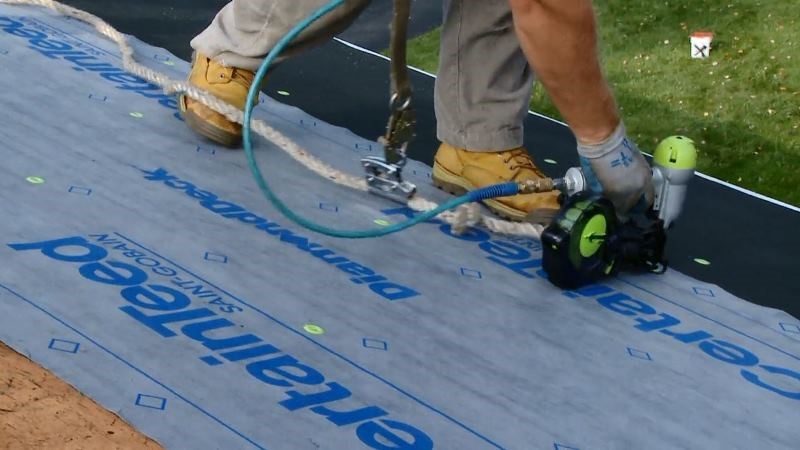[vc_row][vc_column][vc_column_text css=”.vc_custom_1578515232856{margin-bottom: -40px !important;}”]As a homeowner, the joys of wintertime grow substantially smaller, especially when you consider the potential roof damage your home can experience during the winter months. While the falling snow is beautiful, it can pose a substantial threat to your home, especially your roof. There are lots of additional roofing concerns to consider during wintertime, such as ice dams and excess water finding its way into your crawl space.
Rather than worry about your roof all winter long, take the necessary roof deck protection precautions and keep the snow where it belongs.[/vc_column_text][vc_empty_space height=”50px”][vc_row_inner][vc_column_inner][vc_column_text]
What is a Roof Deck?
When you think of a deck, the roof deck is probably not the first thing that comes to mind, but it’s arguably one of the most important features of your roof. Your roof deck is the area located between the external materials, like shingles, and the insulation of your roof. Essentially, it’s the layer that your external roofing materials lay on, so it’s important to make sure this structure is both secure and protected.
Most roof decks are made of a durable plywood, although depending on the weight of your roof structure, steel and cement are popular choices for commercial buildings.
Because this part of your roof structure protects the insulation and supports external materials, it’s imperative that it’s protected all year long. Without it, water leaks and moisture can build within your home, causing roof leaks, mold, and warping in your ceiling.
Different Types of Roof Deck Protection
Since your roof deck is a fundamental part of your roof, having the right roof deck protection prevents excess water from infiltrating your shingles and causing water damage to your roof. Roof deck protection keeps those worrisome external forces, such as snow, wind, rain, and excess water build-up damaging your roof during winter.
The best way to protect your roof deck is with a waterproof roof underlayment. This extra layer of protection is designed to be a barrier between your shingles and roof, and is optimal for keeping your roof protected in any situation.
There are three different types of roof underlayments:
- • Asphalt saturated felt
- • Rubberized asphalt
- • Synthetic felt
While asphalt felt is a fairly common underlayment, because it’s a conventional felt, it’s not water-resistant compared to the other two. Having a more durable material like synthetic or rubberized asphalt gives eliminates greater tear strength, and is a highly optimal roofing underlayment. It’s also compatible with additional construction and external factors, so you’ll never have to worry about damage affecting your asphalt shingles.
When roof underlayment is installed, professional roofers keep in mind various dips, valleys, and weakened areas in your roof, and will take the extra precautions to make sure it’s protected. This way, you’ll never worry about your roof deck or shingles facing additional exposure.
How to Prep Your Roof Deck for Winter
Outside of installing roof underlayment, there are a few additional steps that can help preserve your roof deck for winter. The most important thing to remember is that your roof deck is made of wood – which means it can be worn down and damaged if it becomes exposed. Keep this checklist in mind as you gear up for winter.
- √ Do you have a ventilation system in your home?
-
- If not, have roof ventilation installed in your attic so additional moisture doesn’t build up within your attic, affecting your roof deck. This is how mold can grow in your crawl space, affecting your family’s health.
-
- √ Is your roof looking a little worn down?
-
- Keep an eye out for any holes or missing shingles on your roof. This means your roof deck is exposed and is less likely to prevent wind, rain, and snow from infiltrating your home. If this happens, it’s best to call a local roofing professional right away.
-
- √ Do you have a warranty on your roof?
-
- It’s important that your roof and roof deck protection comes with a warranty. That way, in case the worse happens, you’re prepared.
-
- √ If there are heavier snow falls on certain areas of your roof, check your attic or crawl space to make sure everything is staying dry.
- √ Keep melting salts nearby, in case ice dams are threatening your roof.
In order to prep your roof deck for winter, installing the right roof underlayment is an important step for protecting your home. If you need assistance installing your roof underlayment, or deciding what roof materials are best for your home, contact RJ Turner today.
[/vc_column_text][vc_single_image image=”2535″ img_size=”large” alignment=”center” style=”vc_box_rounded” onclick=”custom_link” img_link_target=”_blank” link=”https://www.turner-remodeling.com/how-much-will-it-cost-to-replace-my-roof/” css=”.vc_custom_1586295871615{padding-top: 5% !important;}”][vc_empty_space height=”20px”][vc_empty_space][/vc_column_inner][/vc_row_inner][vc_row_inner][vc_column_inner][/vc_column_inner][/vc_row_inner][/vc_column][/vc_row][vc_row][vc_column][vc_cta h2=”Ready to get started?” txt_align=”center” color=”white” add_button=”right” btn_type=”action” btn_title=”Contact Us” btn_url=”https://www.turner-remodeling.com/home-renovation/” css=”.vc_custom_1568987175802{background-color: #ed1c22 !important;}” el_class=”white-text”]
Read more and get a free quote at RJ Turner Remodeling.
[/vc_cta][/vc_column][/vc_row]






